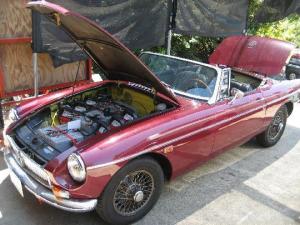| Owner | Mike | ||
|---|---|---|---|
| Location | Santa Clara, California United States map | ||
| Web/Email | WebPage | ||
| Vehicle | 1969 MG MGB A not-too-rusty 1969 donor MGB converted to direct drive 3-phase AC propulsion with re-gen. | ||
| Motor | Hi Performance Golf Cars 35HP peak 10HP continuous 3-Phase AC Motor/controller combo purchased from Hi Performance Golf Cars, Ontario, California. | ||
| Drivetrain | 3 phase AC motor 35HP peak, connected directly to rear differential via belt drive with 1.8:1 gearing ratio. No original transmission used. | ||
| Controller | Curtis 1238 Standard programmable 3-phase 500A Curtis controller with programmable re-gen | ||
| Batteries | 8 Exide Sprinter (GNB), 12.00 Volt, Lead-Acid, AGM Batteries, purchased used from recycler - used to be in telco UPS system. Only 8 months old. | ||
| System Voltage | 96 Volts | ||
| Charger | Vector 2/10/15A I use 8 off-the-shelf charges bought from PepBoys; one for each battery. | ||
| Heater | none | ||
| DC/DC Converter | none I have a small auxiliary battery for lights etc charged separately. | ||
| Instrumentation | minimal. I use a bicycle speed-o for speed and distance (spoked wheels a plus here). Voltmeter to check battery condition. Now have 8 voltmeters and a power meter. | ||
| Top Speed | 65 MPH (104 KPH) It's geared for 65mph top speed. I think 55mph would have been a better choice. | ||
| Acceleration | Curtis controller programming limits acceleration to a reasonable rate. 0-35mph in 9 seconds, 0-50 in 17 seconds | ||
| Range | 40 Miles (64 Kilometers) Calculated range based on energy consumption and battery capacity. After 3 years (5000 miles) my range is now about 20 miles per charge. Very much expected with the lead-acid technology. Lithium next! | ||
| Watt Hours/Mile | 206 Wh/Mile | ||
| EV Miles |
| ||
| Seating Capacity | 2 adults | ||
| Curb Weight | 2,200 Pounds (999 Kilograms) With no gas engine or transmission components the motor/battery weigh almost the same as components removed. | ||
| Tires | standard | ||
| Conversion Time | 4 months or so - mostly locating parts | ||
| Conversion Cost | Donor car $4k, conversion added $6k | ||
| Additional Features | Motor is mounted on a framework that is directly welded to the back axle. This makes the motor un-sprung. Benefits of this design include not having any energy sapping UJs or other couplings. Belt drive is easy to set up and is, so far, very reliable. I dont have a BMS because I charge the batteries separately. It takes about one minute to go around setting all the chargers going. Chargers are 'smart' meaning I can charge the batteries individually without having to disconnect them from each other. | ||
| Update: I converted the headlights from the standard halogen 55W a-piece to household Compact Fluorescent Lights - the curly ones. It turns out the these bulbs work just fine at 96V DC, dont dim as the battery voltage sags and, more importantly, dont flicker out either. Check my website (see 'Update 3') for details. The bulbs I use are 9W each - incandescent equivalent = 40W. I wonder if I'm the only person in the world to have CFLs for headlights? | |||

Copyright © 1997-2025 by Mike Chancey
